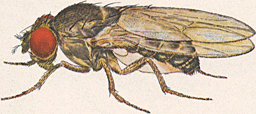Drosophila pseudoobscura
| Drosophila pseudoobscura | |
|---|---|
 | |
| Drosophila pseudoobscura – Male | |
| Scientific classification | |
| Kingdom: | Animalia |
| Phylum: | Arthropoda |
| Class: | Insecta |
| Order: | Diptera |
| Family: | Drosophilidae |
| Genus: | Drosophila |
| Subgenus: | Sophophora |
| species group: | obscura group |
| species subgroup: | pseudoobscura subgroup |
| Species: | D. pseudoobscura |
| Binomial name | |
| Drosophila pseudoobscura Frolova, 1929 [1] | |
Drosophila pseudoobscura is a species of fruit fly, used extensively in lab studies of speciation.
In 2005, D. pseudoobscura was the second Drosophila species to have its genome sequenced, after the model organism Drosophila melanogaster.[2]
Allopatric speciation has been induced by reproductive isolation in D. pseudoobscura after only eight generations using different food types, starch and maltose.[3]
Polyandry in Drosophila pseudoobscura
Females Drosophila pseudoobscura mate through polyandry meaning they mate with more than one male. By mating with multiple males, polyandrous females have more genetically diverse offspring.[4]
Fitness benefits
Prevention of extinction
In the D. pseudoobscura population, some males have a harmful chromosome called sex ratio (SR), where an inactive Y-chromosome is transmitted.[5] If an SR male mates with a female, the female will produce only daughters. Monandry allows the spread of SR and increases the extinction risk in species having SR genes because this makes the SR driver to spread to a high rate to remove one sex.[6] Polyandry decreases the SR gene frequency because the non-SR male sperms outcompete the SR male sperms.[7] Therefore, polyandry results in a decreased risk of extinction in the population.
Increased net offspring survival
Monandrous female D. pseudoobscura do not obtain sufficient sperm or a plenty of suitable sperm for the fertilization. Even though monandrous female experiencing multiple copulations can produce more eggs than polyandrous female experiencing multiple copulations, monandrous females produce less offspring that survive into adulthood than polyandrous females do.[8] This means that polyandrous females have higher egg-to-adult survival ratio than monandrous females, making the polyandrous females more fit.
Mate selection as a fitness benefit
Polyandrous relationships benefit females D. pseudoobscura. In males D. pseudoobscura, the variation in number of sperms shows the difference in benefits between polyandrous and monandrous females.[8] Males D. pseudoobscura ejaculate more sperm than any other Drosophila species, and it provides important nourishing factors to females and their offspring. The offspring viability benefits are increased by multiple and variable sperms through ejaculates.[8] There are no additional costs to polyandrous females, because there are not big differences in life expectancy between monandrous female experiencing multiple copulations and polyandrous female experiencing multiple copulations.[8]
Evolutionary consequences
Polyandry, in general, may have a few fitness consequences. Densely populated areas may have lower rates of polyandry due to environmental restraints such as geographic location and limited resources. This can greatly limit the survival and reproduction of offspring.[9] Therefore, in population dense areas, polyandrous behavior may actually be a fitness consequence since the environment significantly controls the number of offspring that survive.[9]
Polyandry could also pose genetic fitness consequences. Polyandry does not always result in the spread of the most adaptive genes. For example, some individuals may appear to be attractive due to genes that code for increased pheromone production.[10] As a result, attractive individuals are more likely to reproduce more often.[10] However, since these individuals do not always contain adaptive genes, multiple mating events do not always result in the propagation of adaptive genes.[10]
References
- ↑ "Drosophila pseudoobscura". Integrated Taxonomic Information System.
- ↑ S. Richards, Y. Liu, et al. (2005). "Comparative genome sequencing of Drosophila pseudoobscura: Chromosomal, gene, and cis-element evolution". Genome Research. 15 (1): 1–18. doi:10.1101/gr.3059305. PMC 540289
 . PMID 15632085.
. PMID 15632085. - ↑ D. M. B. Dodd (1989). "Reproductive isolation as a consequence of adaptive divergence in Drosophila pseudoobscura" (PDF). Evolution. 43 (6): 1308–1311. doi:10.2307/2409365.
- ↑ Price, T.A.R.; Hodgson, D.J.; Lewis, Z.; Hurst, G.D.D.; Wedell, N. (2008). "Selfish Genetic Elements Promote Polyandry in a Fly". Science. 322: 1241–1243. doi:10.1126/science.1163766.
- ↑ Price, Tom A. R.; Lewis, Zenobia; Smith, Damian T.; Hurst, Gregory D. D.; Wedell, Nina. "Sex ratio drive promotes secual conflict and sexual coevolution in the fly drosophila pseudoobscura". Evolution. doi:10.1111/j.1558-5646.2009.00896.x.
- ↑ Price, T.A.R.; Bretman, A.; Gradilla, A.C.; Reger, J; Taylor, M.L.; Giraldo-Perez, P.; Campbell, A.; Hurst, G.D.D.; Wedell, N. (2014). "Does polyandry control population sex ration via regulation of a selfish gene?". Proc. R. Soc. B. 281: 20133259. doi:10.1098/rspb.2013.3259.
- ↑ Price, T.A.R.; Hurst, G.D.D.; Wedell, N. (2010). "Polyandry Prevents Extinction". Current Biology. 20: 471–475. doi:10.1016/j.cub.2010.01.050.
- 1 2 3 4 Gowaty, P.A.; Kim, Y.; Rawlings, J.; Anderson, W.W. (2010). "Polyandry increases offspring viability and mother productivity but does not decrease mother survival in Drosophila pseudoobscura". PNAS. 107 (31): 13771–13776. doi:10.1073/pnas.1006174107.
- 1 2 Pai, Aditi; Feil, Stacy; Yan, Guiyun (2007-01-19). "Variation in polyandry and its fitness consequences among populations of the red flour beetle, Tribolium castaneum". Evolutionary Ecology. 21 (5): 687–702. doi:10.1007/s10682-006-9146-4. ISSN 0269-7653.
- 1 2 3 Boake, Christine R. B. (1985-03-01). "Genetic Consequences of Mate Choice: A Quantitative Genetic Method for Testing Sexual Selection Theory". Science. New Series. 227 (4690): 1061–1063. doi:10.1126/science.227.4690.1061. JSTOR 1694818.
External links
| Wikispecies has information related to: Drosophila pseudoobscura |
- Drosophila pseudoobscura at FlyBase
- Drosophila pseudoobscura at Ensembl Genomes Metazoa
- View the dp3 genome assembly in the UCSC Genome Browser.